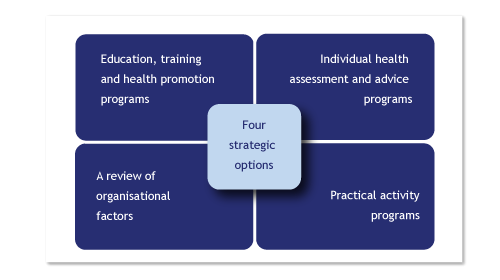| Show/Hide Hidden Text |

The budget and the nature of the workplace will influence whether one or a combination of approaches is incorporated.
1. Education, training and health promotion programs
Providing information to employees that promotes healthy behaviour is central to any health and wellbeing program. A health-savvy workforce is more likely to participate in health initiatives and will be able to make better decisions about their own health. These kind of programs work best when they are targeted. This means that clear decisions need to be made on:
Which topics should the program focus on? The most effective way to choose focus topics is to identify the most common problems impacting the workplace and plan an approach according to the available budget. Ask: Which conditions are common in the workplace? and Which health behaviours are lacking? How do we get the information ‘out there’? When it comes to getting health information out to your employees, the best approach is to use a range of communication methods. Some effective options are to: Provide employees with pre-existing written information
|
2. Individual assessment and advice program
This strategy uses a personalised approach to identify health problems and provide assistance. Employees are given the opportunity to undergo an individual health assessment. The important components of this system are that:
This approach is more expensive, however it can be very effective. |
3. A review of organisational factors that contribute to health and wellbeing
One of the simplest ways to improve employee health and wellbeing is to review how the work environment and job requirements impact on staff health. There are a couple of things to consider… Workplace atmosphere and culture Workplace culture has a huge influence on health and wellbeing outcomes. For a definition of workplace culture, see “The way things are done around here…” In terms of health and wellbeing programs, the important questions to ask are:
Employees who feel overwhelmed by work expectations are likely to be more stressed, and high levels of stress can have a significant impact on health. High levels of stress contribute to common problems such as fatigue, depression, hypertension and anxiety. If employees report high levels of stress or find it hard to achieve balance in their lives, health and productivity are likely to be affected. Stress is often higher in some departments than others. If so, consider the issues in departments that report high stress levels. What lessons can be drawn from departments that perform better? Providing a healthy environment There is a great deal that employers can do provide a healthy work environment. A healthy environment lets staff know they are important, and reinforces the intent of the health program. Simple, practical measures make a difference. For example, one option is to support employees to have a healthily diet while they’re at work. Providing a refrigerator and a microwave makes it easier for employees to bring their own food from home. Healthy food in the canteen or cafeteria helps, however it needs to be an attractive option or employees won’t choose to purchase it. |
4. Practical activity programs
There are heaps of practical activities that promote better health. Exercise, for example, can be promoted by:
|
|
There are a number of things to consider when deciding which options are most appropriate for a workplace, including how the selected options will fit together.
Don’t spend time and money on an impractical program! A ride-to-work program, for example, might sound like a low-cost, high return option, but it won’t be effective unless there is a good bicycle route near the workplace and significant numbers of employees living within a reasonable distance. Further, if a ride-to-work program is to be effective, facilities for employees to shower and change at work will be needed. |
The culture of the organisation needs to be considered when deciding on program components. Some measures are likely to get a good response from particular workforces, while others are likely to strike the wrong note. |
3. Putting the pieces together: integrating options
Once program approaches have been chosen, a plan to integrate the steps should be drawn up. If an external provider has been engaged, program integration should be discussed with the provider. Health promotion efforts (eg. a newsletter and posters in the workplace) work best if focused on one condition at a time, with the focus staying on each condition for six months. Begin with the most important health condition, and then, after six months, move to the next most important health condition, and so on. A general health promotion on two topics could include in-depth information sessions on diabetes in one half of the financial year, followed by depression in the next. Supporting material – for example leaflets and posters about the relevant health condition – could be distributed around the workplace following each information session. After the session on diabetes, free fruit could be provided to workers, and healthy eating options from the canteen could be introduced and / or advertised. Following the session on depression, in-house counselling services or EAP programs (where available, see below) could be promoted and exercise (for example, riding to work) encouraged. Not all measures need to be integrated, but it is sensible to have a “big picture” sense of the way they fit together, and the ways in which each element contributes to the goals and priorities during the assessment period. |
4. Health and wellbeing ‘add-ons’: Employee Assistance Programs (EAPs)
Wellness programs can be supported by other ‘add-on’ programs, for example "Employee assistance programs" or EAPs. EAPs provide psychological support services for staff in need of assistance. The support can be for work or non-work-related issues. Important facets of EAPs include:
|